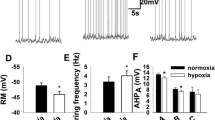Abstract
Vertigo is one of the most common clinical symptoms. However, the chemical processes involved in the pathological mechanism of vertigo remain to be fully understood. In this study, we investigate the dynamic changes in the magnesium (Mg2+) concentration in medial vestibular nucleus (MVN) of guinea pigs following vertigo induced by vestibular ice water stimulation with an electrochemical detection method consisting of in vivo microdialysis and on-line selective electrochemical detection. Electrochemical detection of Mg2+ was accomplished based on the current enhancement of Mg2+ towards the electrocatalytic oxidation of NADH at the electrodes modified with the polymerized film of toluidine blue O (TBO). Selectivity for the on-line electrochemical detection against Ca2+ was achieved by using ethyleneglcol-bis(2-aminoethylether) tetraacetic acid (EGTA) as the selective masking agent for Ca2+. The basal level of the extracellular Mg2+ in the MVN of guinea pigs was determined to be 759.7 ± 176.2 μM(n = 16). Upon ice water irrigation of the left external ear canal, the concentration of Mg2+ in the MVN decreases significantly, reaches 72 ± 6% (n = 8) of the basal level, and maintains for at least 1000 s. Control experiments reveal that neither warm water irrigation of the external ear canal nor ice water irrigation of the auricle induces the decrease in the concentration of Mg2+ in the MVN. These results demonstrate that the extracellular Mg2+ in the MVN decreases significantly following vertigo induced by vestibular ice water stimulation. This demonstration suggests that Mg2+ might play an important role in the pathological mechanism of vertigo.
Similar content being viewed by others
References
Neuhauser HK. Epidemiology of vertigo. Curr Opin Neurol, 2007, 20(1): 40–46
Karatas M. Central vertigo and dizziness: Epidemiology, differential diagnosis, and common causes. Neurologist, 2008, 14(6): 355–364
Jonsson R, Sixt E, Landahl S, Rosenhall U. Prevalence of dizziness and vertigo in an urban elderly population. J Vestib Res, 2004, 14(1): 47–52
Sloane PD, Coeytaux RR, Beck RS, Dallara J. Dizziness: State of the science. Ann Intern Med, 2001, 134(9 Pt 2): 823–832
Matsuoka I, Ito J, Takahashi H, Sasa M, Takaori S. Experimental vestibular pharmacology: A minireview with special reference to neuroactive substances and antivertigo drugs. Acta Otolaryngol Suppl, 1984, 419: 62–70
Inoue S, Yamanaka T, Kita T, Nakashima T, Hosoi H. Glutamate release in the rat medial vestibular nucleus following unilateral labyrinthectomy using in vivo microdialysis. Brain Res, 2003, 991(1–2): 78–83
Yamanaka T, Sasa M, Matsunaga T. Release of glutamate from the vestibular nerve in the medial vestibular nucleus as a neurotransmitter: in vivo microdialysis study. Acta Otolaryngol Suppl, 1995, 520(Pt 1): 92–93
Olesen J. Calcium entry blockers in the treatment of vertigo. Ann N Y Acad Sci, 1988, 522: 690–697
Saris NE, Mervaala E, Karppanen H, Khawaja JA, Lewenstam A. Magnesium. An update on physiological, clinical and analytical aspects. Clin Chim Acta, 2000, 294(1–2): 1–26
Elin RJ. Magnesium metabolism in health and disease. Dis Mon, 1988, 34(4): 161–218
Cox JA, Lysko PG, Henneberry RC. Excitatory amino acid neurotoxicity at the N-methyl-D-aspartate receptor in cultured neurons: role of the voltage-dependent magnesium block. Brain Res, 1989, 499(2): 267–272
Sakai N, Ujihara H, Ishihara K, Sasa M, Tanaka C. Electrophysiological and pharmacological characteristics of ionotropic glutamate receptors in medial vestibular nucleus neurons: A whole cell patch clamp study in acutely dissociated neurons. Jpn J Pharmacol, 1996, 72(4): 335–346
Milani D, Guidolin D, Facci L, Pozzan T, Buso M, Leon A, Skaper SD. Excitatory amino acid-induced alterations of cytoplasmic free Ca2+ in individual cerebellar granule neurons: Role in neurotoxicity. J Neurosci Res, 1991, 28(3): 434–441
Izumi Y, Roussel S, Pinard E, Seylaz J. Reduction of infarct volume by magnesium after middle cerebral artery occlusion in rats. J Cereb Blood Flow Metab, 1991, 11(6): 1025–1030
Vink R, Cook NL, den Heuvel CV. Magnesium in acute and chronic brain injury: An update. Magnes Res, 2009, 22(3): 158S–162S
Cevette MJ, Vormann J, Franz K. Magnesium and hearing. J Am Acad Audiol, 2003, 14(4): 202–212
Muroyama A, Inaka M, Matsushima H, Sugino H, Marunaka Y, Mitsumoto Y. Enhanced susceptibility to MPTP neurotoxicity in magnesium-deficient C57BL/6N mice. Neurosci Res, 2009, 63(1): 72–75
Rapisarda C, Bacchelli B. The brain of the guinea pig in stereotaxic coordinates. Arch Sci Biol (Bologna), 1977, 61(1–4): 1–37
Zhang Z, Zhao L, Lin Y, Yu P, Mao L. Online electrochemical measurements of Ca2+ and Mg2+ in rat brain based on divalent cation enhancement toward electrocatalytic NADH oxidation. Anal Chem, 2010, 82(23): 9885–9891
Takumida M, Anniko M. Nitric oxide in the inner ear. Curr Opin Neurol, 2002, 15(1): 11–15
Calabrese V, Cornelius C, Maiolino L, Luca M, Chiaramonte R, Toscano MA, Serra A. Oxidative stress, redox homeostasis and cellular stress response in Meniere’s disease: Role of vitagenes. Neurochem Res, 2010, 35(12): 2208–2217
Astier C, Rock E, Lab C, Gueux E, Mazur A, Rayssiguier Y. Functional alterations in sarcoplasmic reticulum membranes of magnesium-deficient rat skeletal muscle as consequences of free radical-mediated process. Free Radic Biol Med, 1996, 20(5): 667–674
Author information
Authors and Affiliations
Corresponding authors
Rights and permissions
About this article
Cite this article
Xin, Y., Zhang, Z., Yu, P. et al. In vivo electrochemical recording of continuous change of magnesium in medial vestibular nucleus following vertigo induced by ice water vestibular stimulation. Sci. China Chem. 56, 256–261 (2013). https://doi.org/10.1007/s11426-012-4567-0
Received:
Accepted:
Published:
Issue Date:
DOI: https://doi.org/10.1007/s11426-012-4567-0




